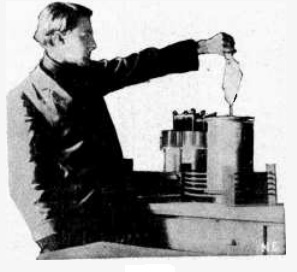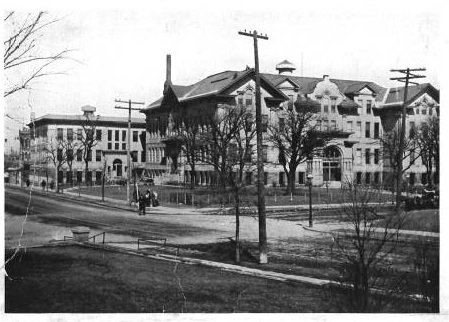The June 1911 issue of Modern Electrics magazine carries an interesting article written by one Norman Barden, detailing experiments being carried on at East High School in Minneapolis. Among other things, the reason why the article caught my eye was that this school was the predecessor of my alma mater, Minneapolis Edison.
East High was opened in 1900 and operated under that name until 1927, at which time it was used as a vocational school for a number of years. It was located between University Avenue and Southeast Fourth Street on what was then First Avenue Southeast, which was later renamed Central Avenue. Edison opened in 1922 and Marshall High (in whose old building I had my office for a number of years) opened in 1924, eliminating the need for East High. So in a sense, I went to the same school.
Barden starts his article by pointing out that the “public has been startled” to learn that a high-frequency current can pass through the human body with no ill effects. He explains that “there are several different theories put forth to explain why high frequency current does not produce fatal results upon animals and the human body,” even though the same current and voltage at a lower frequency or at DC, “fatal results occur.”
 Undaunted by the possibility of fatal results, and apparently oblivious as to the reason why they were non-fatal, Barden went ahead and sent the potentially fatal currents through humans, including himself, as shown in the picture here.
Undaunted by the possibility of fatal results, and apparently oblivious as to the reason why they were non-fatal, Barden went ahead and sent the potentially fatal currents through humans, including himself, as shown in the picture here.
(It turns out that the explanation for the non-lethality is somewhat mundane. The equipment appears to be an ordinary Tesla coil, meaning that while the voltages are very high and will generate a most impressive spark, the current passing through the human subject is extremely small.)
It turns out that this wasn’t the only dangerous science going on at East High. Mr. Barden was apparently shooting guns in the photography lab, as detailed in other published articles. In articles in the May 1911 issue of Popular Electricity and the 1914 Journal of the U.S. Artillery, he publishes photos of bullets photographed in flight after being shot from a .22 caliber rifle and a .32 caliber revolver. Not surprisingly, he points out that when you fire guns at school, “a back-stop must be provided to keep the bullets from penetrating the wall.” He used a piece of boiler plate behind a 2-1/2 inch piece of wood. He also points out that you need to be careful, since you’re doing the experiment (including firing the gun) in a totally darkened room. If you are going to replicate his experiment, it’s probably not a good idea to walk around after turning out the lights. Barden is shown below with his co-experimenter, Loyle Dobbs. The 1914 article also appeared in Scientific American.
As you can see, the rifle is plainly visible in this photo. Apparently, East High didn’t have a “no guns” sign on the front door.
In addition to these publications, Barden also had published in a 1910 issue of Popular Atronomy a photograph of a comet he had taken through a telescope he had constructed himself.
When I saw the original article, I assumed that Mr. Barden was a teacher at the school. But it turns out that he was actually one of the students. A hundred years ago, high school students could get their articles published in Scientific American. Today, they’re not allowed to touch the experiments.
 The first record of young Mr. Barden is an article in the the June 14, 1906 Minneapolis Journal, where he is listed as a seventh grade student at Holmes School. He’s shown here in his East High yearbook photo, which shows that he graduated in January, 1912. In 1913, he is listed as a sophomore at the University of Minnesota College of Science, Literature, and the Arts. And in 1919, he graduated from medical school in Ohio.
The first record of young Mr. Barden is an article in the the June 14, 1906 Minneapolis Journal, where he is listed as a seventh grade student at Holmes School. He’s shown here in his East High yearbook photo, which shows that he graduated in January, 1912. In 1913, he is listed as a sophomore at the University of Minnesota College of Science, Literature, and the Arts. And in 1919, he graduated from medical school in Ohio.
He returned to Minneapolis in time for the 1920 census, and went into practice. In this 1921 directory, he is shown as having an office in the Donaldson Building and a home address of 1209 7th St. SE. According to the 1921 Journal-Lancet of the Minnesota State Medical Association, He was the assistant to Dr. C.D. Harrington, a “pioneer in the therapeutic use of radium and the x-ray,” and the rongenologist of Northwestern, Asbury, Abbott, and St. Mary’s Hospitals.
Unfortunately, Dr. Barden’s promising scientific career came to a tragic end with his mysterious death in 1926.
The newspapers of August 18, 1926 reported that one Mrs. J.D. McDermott, the wife of a Chicago millionaire contractor, was being held by Minneapolis police following Dr. Barden’s death. His body was found by police in a room occupied by the couple in a downtown hotel. According to news accounts, the doctor was found “fashionably dressed and wearing several diamond rings said to be worth more than $10,000.” Two days later, the papers reported that Mrs. McDermott had been released, the post mortem having determined that the doctor had actually died from “acute alcoholism.”
Dr. Barden is buried at Lakewood Cemetery in Minneapolis.
Click Here For Today’s Ripley’s Believe It Or Not Cartoon ![]()


